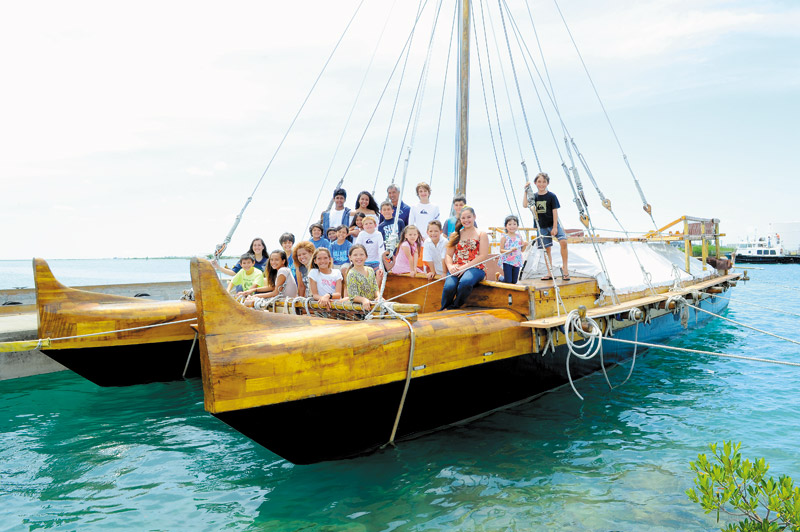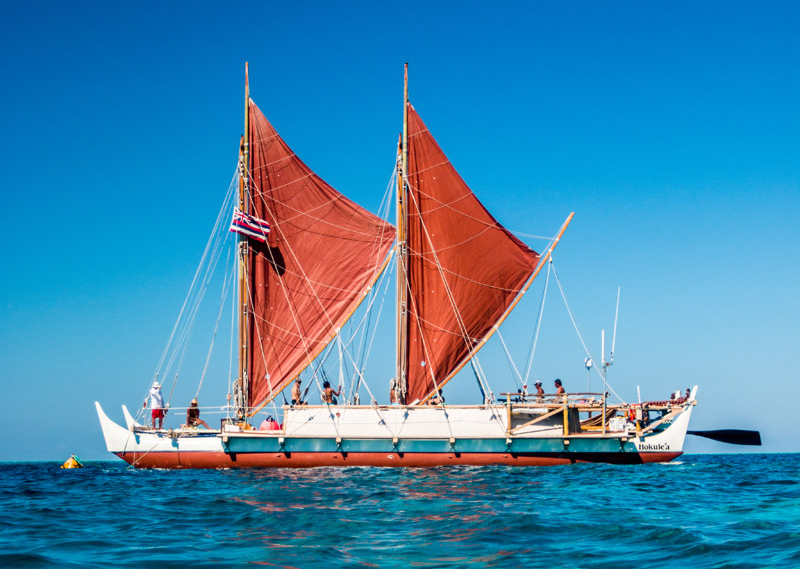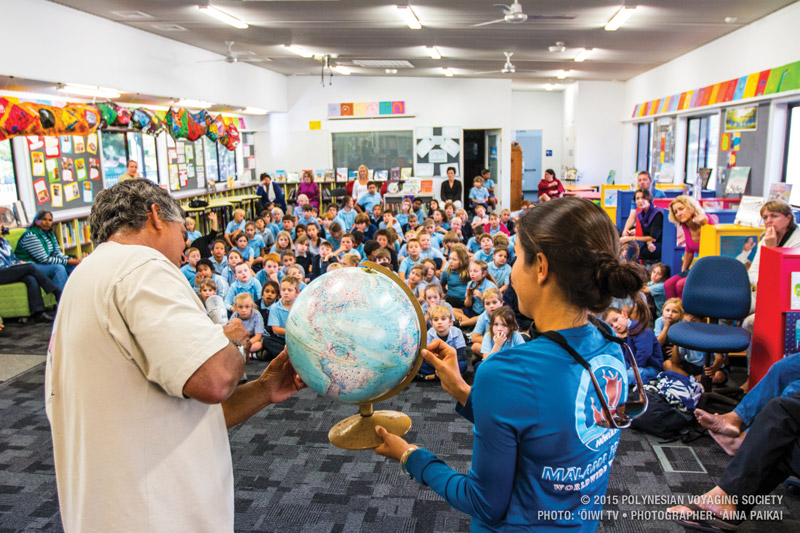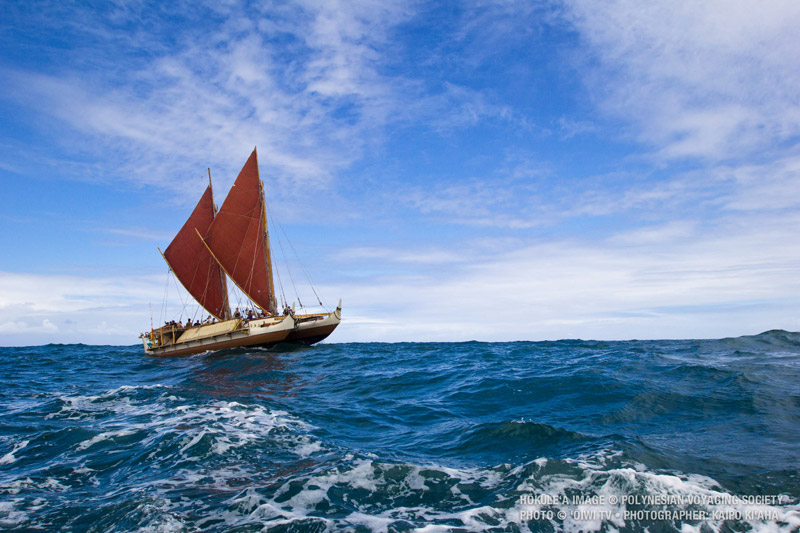Sail On

The mission of Malama Honua Worldwide Voyage is to bring the voyage to the hearts and minds of children all over the world, including these students aboard another double-hulled canoe, Hawai‘iloa.
PHOTO BY LAWRENCE TABUDLO
How do you treat a true icon, a symbol so powerful it awoke a slumbering culture and revitalized its people? Do you put it under glass, hermetically sealed so that future generations can bear witness to this touchstone that reignited the fire of what it meant to be Hawaiian?
Or, do you take it out and use it for the purpose for which it was created? Maybe allow the briny depths to eat at its hull, the winds to tear at its sails and its decks to be worn down by the feet of acolyte navigators while they learn to explore the planet as their forefathers did millennia ago?
These were the questions facing the Polynesian Voyaging Society when planning for the Hōkūle‘a Mālama Honua voyage began. On Saturday, the double-hulled voyaging canoe wraps up its three-year journey that included stops at hundreds of ports in 23 countries, with a triumphant return by sailing into Magic Island. One of those global stops, in fact, turned out to be reminiscent of George Bailey’s vision in the 1946 film classic, It’s a Wonderful Life, and is responsible for giving society members a glimpse at what might have been had they chosen preservation over education with Hōkūle‘a.
It happened while in Indonesia on the island of Java as members visited the Borobudur Temple, the largest Buddhist monument in the world. Built in the eighth century, the temple is adorned with carvings, one of which features a sailing vessel believed to have transported ancient Indonesians to their islands. Much like Hōkūle‘a, the vessel was recreated and put to use, sailing along the old Cinnamon Route to Africa and Madagascar. But upon its return home, the people inexplicably chose another path: to permanently dock the vessel.

Hōkūle‘a’s three-year journey comes to an end Saturday when it sails into Magic Island.
PHOTO COURTESY OF POLYNESIAN VOYAGING SOCIETY
“The government there built a ship based on these drawings and sailed it along the ancestral route, but then they brought it home and built a museum around it and never sailed it again,” explains Miki Tomita, a crew member of the Hōkūle‘a and director of the Polynesian Voyaging Society’s Learning Center. “When we talked to their conservationist, they said, ‘Imagine if we had kept sailing this ship, what would it have done for our people? We would be a different people.’ It made me realize how lucky we are that our leadership and elders decided not to put Hōkūle‘a in a museum and decided to keep her sailing. She has inspired the world because of it.”
The very thought of taking the Hōkūle‘a out of the hands of his novice navigators sets Nainoa Thompson’s teeth on edge.
“The worst thing you can do is to tie Hōkūle‘a to a dock or put her in a museum,” says Thompson, Hōkūle‘a navigator and society president. “This would take the life form, spirit and mana of Hōkūle‘a away from the world. This canoe drove renaissance in Hawaii, restored dignity and pride in the Hawaiian people and changed educational priorities and policies so that native language and culture are now honored.
“Hōkūle‘a has reunified the people of the Pacific and set history right,” he adds. “Because of Hōkūle‘a, there are now 25 deep-sea voyaging canoes and 2,500 voyagers throughout the Pacific. The mission, values and purpose of Hōkūle‘a continue because she sails.”

Hōkūle‘a’s 40,000-mile journey around the world allowed students to learn about the double-hulled canoe’s mission, values and purpose. PHOTOS COURTESY OF POLYNESIAN VOYAGING SOCIETY/OIWI TV
All of this simply reinforces Tomita and society members’ views on the importance of their mission, which is to educate others.
“I have always been an advocate for traditional knowledge and indigenous science, and the knowledge that is held in our community historically and ancestrally is the pathway to lead the world to a better future. That dedication has just been amplified by this voyage,” says Tomita, a Maui native and Baldwin High School graduate. “You see it in South Africa, you see it in Bali and the Galapagos. We have been to all these magical places and found that people all over the world all have this same intuition, and Hōkūle‘a has allowed us to articulate that and take it all over the world.”
Tomita and her colleague, society education coordinator Jenna Ishii, have spent the past decade putting together Hōkūle‘a’s educational plan, which includes the new master’s program at the University of Hawai‘i at Mānoa’s College of Education. The program created “more than a thousand dots on the map,” according to Ishii, and required participants to make contact with several learning centers in each of the 150 ports that Hōkūle‘a visited during her 40,000-mile trek around the globe.

Children marvel at the craftsmanship of the Hōkūle‘a
“We wanted to do something very different than we have ever done before. It wasn’t about creating a curriculum book to learn about voyaging, it was about creating a global community focused on caring for the earth,” explains Ishii, whose first sailing experience came aboard Hōkūle‘a. “How do we get Mālama Honua, or caring for the earth, at the core of purpose of education in Hawai‘i? That became our driving question in our Island home, and as we went around the world, what are we doing to inspire people to care for their ocean, their communities and their homes? It is not just a nice thing to do, but an urgent need.”
The union between Tomita and Ishii began a decade ago when they met while working on curriculum for Kaho‘olawe. The two came from such disparate backgrounds — Ishii as a communications major and Tomita as a biosystems engineer. Still, they were able to find common ground on the deck of the wa‘a.
Together, they formulated a plan with the help of Robert Witt, the executive director of the Hawai‘i Association of Independent Schools, and received input from entities as big as the University of Hawai‘i and the state Department of Education to those as tiny as Hawaiian immersion schools. Their goal: to put caring for the earth back into the hearts of the children.
So, they got to work. The plan involved a blending of the old and new, for it is technology that has helped to flatten the earth, but it is those quiet moments aboard the canoe, surrounded by nothing but blue and only the stars, that guides participants to commune with the planet. And yet, to bring the experience to the masses, they had to set up video messages and conduct live updates, which were broadcast to contacts throughout the globe, in order to demonstrate the power of the canoe.
“We look at her as a neutral platform for people from any race or background to come to have a place for conversation,” says Tomita. “When you get on board, she is not a political entity; she stands for peace, aloha and Hawaiian values and spirit, but anyone is allowed on if they have those right values. She brings together people that would normally never collaborate, people that come from opposite ends of the spectrum, (and it’s) very interesting to see what she can do to bring communities together.”
Seeing people of such different backgrounds, confined to a tight space and not only getting along, but truly helping and caring for one another, was an eye-opening experience for crew members.
“You become your best possible self,” says Ishii. “It is one of those amazing circumstances that is in such contrast to your regular lives. … When you are in this much smaller microcosm and everything you do is visible to everyone else and there is a high sense of accountability and love, the crew tends to mālama each other. You fight over washing dishes, you help each other out, and you come up to watch five minutes early. You practice these behaviors every day, and the challenge is how you continue to do that once you hit land again.”
There is much to be learned from the explorers who operate the canoe, but it is a two-way street, as students worldwide participate in the Mālama Honua Challenge. In the case of students in Florida, for example, their biggest challenge was to provide the Hōkūle‘a crew with fresh fruits and vegetables.
“Growing food is the most difficult one, and we are working with a number of schools throughout the world, including 280 schools in the public school system in Florida,” said Thompson last year while in the Everglades. “They are doing the research for us and they are working with the garden schools in Hawai‘i with the goal of making both the canoes‘ food sustainable. There isn’t any failure in this endeavor; the only failure would be to tie the canoe to the dock and not try. The food experiment is the hardest, and that is what makes it the best because it is the hardest.”
While developing problem-solving skills and working to preserve the planet are essentials of the curriculum, the youths are encouraged to both learn with their heads and make connections within their hearts.
“I go back to the moment in Cape Town, halfway around the world from Hawai‘i,” recalls Ishii. “It was really the turning point for our voyaging community. You never quite know if you are making a difference, but when we visited this local township school, there was barbed wire all around and they don’t have all the things that our kids have here in Hawai‘i. It was a very humbling experience.
“That day, we didn’t even go into the classrooms. All the kids came outside, and we had a delegation of students from Kamehameha Schools and Halau Ku Mana, and they danced for the kids and the kids from Cape Town danced for us and sang and for a couple hours. We just danced and sang and taught each other, and that moment is why we sail and what Hōkūle‘a stands for. It’s about peace and the basic human potential of aloha.
“We are one planet and we may not all speak the same language, but we can connect and value the same things.”
From Canoe To Classroom
Hōkūleʻa crew members Miki Tomita and Jenna Ishii share how the iconic canoe has allowed today’s youth to thrive.

Polynesian Voyaging Society Photo
Wa‘a Talks
Piloted at Punahou School in Spring 2014, 13 Wa‘a Talks sessions took place between September 2014 and April 2017, and were attended by 590 educators.
Promise to the Children
One of the Worldwide Voyage’s core missions is to engage learners across the globe. The Promise to Children outlines the strong bond between the voyaging and education communities starting in Hawai‘i. “It’s a simple document that is written by and authored by educational leadership in Hawai‘i. But it’s a document that we put on Hule‘a, and we take it around the world,” said Nainoa Thompson. More than 175 education organizations have already committed to support the Worldwide Voyage (WWV), including Kamehameha Schools, the state Department of Education and University of Hawai‘i at Manoa.
Canoe to Classroom
Crewmembers adopted classes at the start of the voyage, and stayed in close touch with those students throughout the exciting international legs, sharing stories and providing educational experiences through video chats from the decks of the voyaging canoes while at sea. More than 250 connections were made with thousands of students from the deck of the canoe as she crossed every ocean and from ports around the world.
Hawai‘i Delegations
Local students and teachers traveled to meet Hule‘a in key ports like Aotearoa, Australia, Cape Town, Virginia, Washington D.C., New York City, Miami, Galapagos Islands, Rapa Nui and Tahiti, bringing gifts from home and experiencing once-in-a-lifetime cultural exchanges with local communities around the world.
UH College of Education
A‘o Hawai‘i Teacher Training program for the Worldwide Voyage was institutionalized into the STEMS^2 Master’s Program at the UH College of Education.
Credit Classes at Local Schools
Institutions such as Castle High School and Kamehameha Schools-Kapalama created for-credit electives focused on the values of voyaging and malama honua.
Succession Leadership
The next generation of navigators and captains trained and sailed in support of WWV. In addition, multi-generational legacy of the art and science of wayfi nding were prevalent during WWV.
Nā Kelamoku Youth Leadership Initiative
The Youth Leadership Initiative (YLI) of Polynesian Voyaging Society aims to cultivate the next generation of navigators and explorers in Hawai‘i. In 2014, youth leaders agreed on calling the YLI, “Na Kelamoku – The Sailors.” It captures their intent to become voyagers through learning traditional Polynesian voyaging techniques. NaKelamoku aims to cultivate the passion for ‘ike Wa‘a and dedication to malama honua in the next generation of navigators and explorers in Hawai‘i. Five members of Na Kelamoku have sailed on the WWV.
Educators on Wa‘a
Every crew leg includes an educational specialist and a science specialist. Eighty formal and informal educators participated as crew members and land-based volunteers on the Worldwide Voyage during the international legs, and 387 formal and informal educators participated in the Hikianalia Statewide Sail.
Science at Sea
Hōkūleʻa and Hikianalia are home to several science research efforts during the Worldwide Voyage. These focus on:
1) plankton populations research;
2) water quality and research;
3) marine debris collection and plastic pollution research; and
4) fish DNA and population research. Data related to each area of study is collected at sea and in port, where possible.





